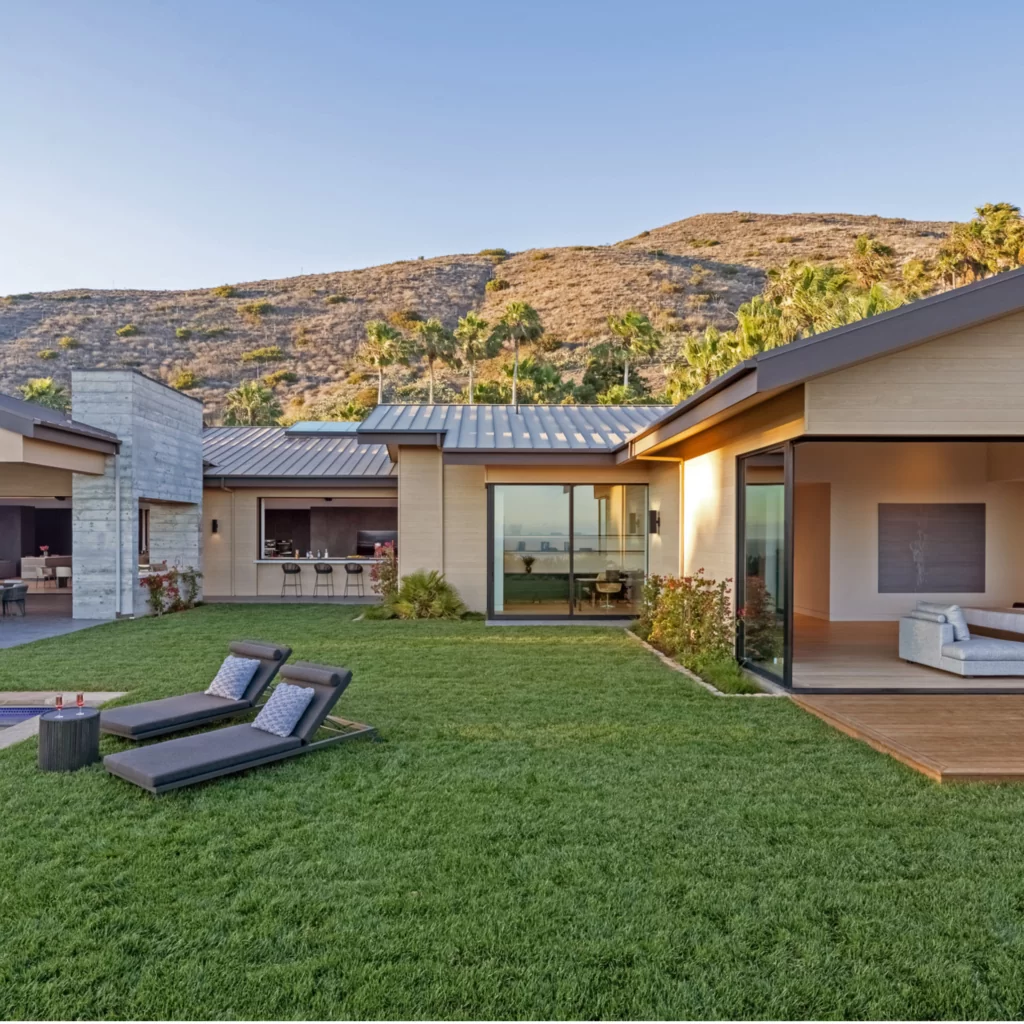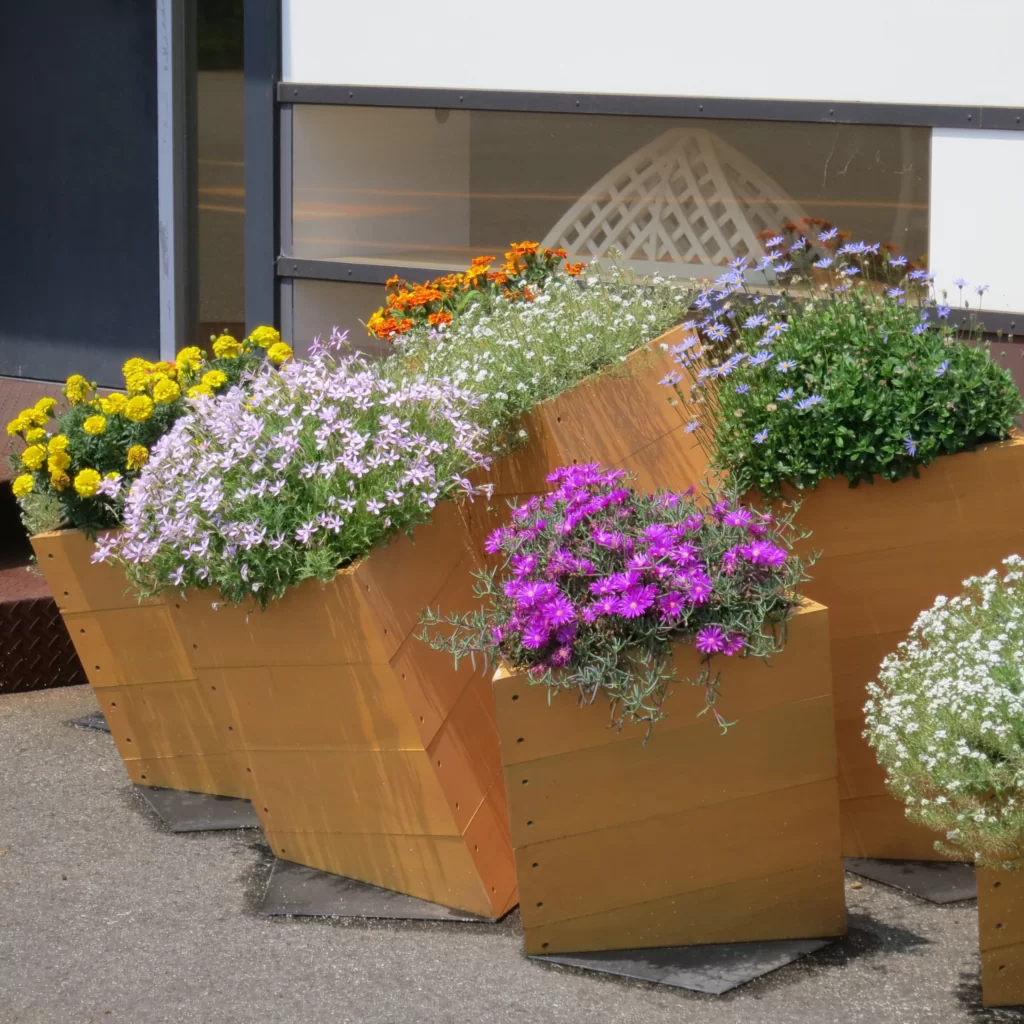
10 great examples of Japanese burnt wood siding (Shou Sugi Ban)
If you’re looking for a siding material that creates a distinctive texture but one that’s also visually striking and adds a unique character to the exterior, look no further than Japanese burnt wood siding, also known as Shou Sugi Ban.
06.29.2023

What is Shou Sugi Ban?
Shou Sugi Ban has been around for hundreds of years and has a long history in Japan. The technique—which includes burning the surface of the wood to create a layer of char that protects it from weathering, insects, and rot—originated in the 18th century to help preserve cedar siding on traditional Japanese homes and temples.
Shou Sugi Ban then gained popularity worldwide, with designers, architects, and homeowners using charred Accoya wood for various applications. Its durability, sustainability, and unique appearance make it a sought-after material for modern residential and commercial design projects.
Here are 10 stunning examples to inspire you if you consider installing for your Shou Sugi Ban house or other projects.

Modern touches meet sustainability
For this ultra-modern home, Shou Sugi Ban is aesthetically beautiful, and the dark finish also achieves a striking, standout appeal. Utilizing charring as a surface treatment is a natural, sustainable, non-toxic alternative to treated wood that harms people and the environment.

Beautiful and energy efficient
This Passive House in Utah is not only sustainable and energy efficient, the gorgeous exterior is wrapped in charred Accoya wood, fitting the eco-conscious theme—but is designed to last, providing stability throughout the seasonal changes in Utah.

Chicago two-tone
This simple two-story home in Chicago used two shades of charred Accoya wood. The base is concrete, while the upper levels used an Accoya wood façade system in two different shades – grey and black. The façade mirrors the internal arrangement of the two floors. Not so simple anymore!

Swimming in design
Sometimes a pool house is just a pool house, but in this case, the homeowner went deep and chose Accoya Barnwood Siding in Delta Black by Delta Millworks. The result is a modern, beautiful structure that will delight the homeowners to enjoy during the summer and show off at future pool parties.

Going coastal
Accoya’s MATSU (from the Japanese term ‘pine tree’), by reSAWN Timber Co., provided a burnt look on the outer facing side of the tongue and groove cladding but also extreme durability, exterior weathering capabilities, FSC®-certification, exterior warranty, and the hardiness of Accoya for those brutal coastal conditions.

Unique and Striking with Accoya
Manufactured by reSAWN TIMBER Co., Accoya was used to bring a unique and striking look to this private residence. A specific range of Accoya wood, MATSU Shou Sugi Ban, was selected for the project. This charred cladding is burnt on the visible side only and then sealed on its face and back.

Slatted for luxury
A deep gray, slatted Accoya wood covers the exterior, while charred, stained, sealed, and deep gray, slatted Accoya wood siding by reSAWN Timber Co. enhances the roofscape’s dynamic edges and arcs. Accoya was chosen for its durability, low maintenance, and distinctly contemporary appearance.

Not your grandfather’s garage
This striking facade for this homeowner’s garage is made from Accoya wood but was left uncoated to reveal the natural light coloring of Accoya. In complete contrast, the garage itself was clad using charred Accoya. The two varying finishes complement each other well and show just how versatile Accoya is.

Not just for homes
Who says fire stations have to be drab, concrete affairs?
This fire station in Aspen used Accoya Smooth Coastline by Delta Millworks, which provides splashes and accents to break up the fire station’s exteriors.

Ready for its close up
Last is an up-close look at one of our Shou Sugi Ban—Accoya Deep Char, by Pioneer Millworks. An additional feature of Accoya’s Shou Sugi Ban wood is that the grain is emphasized much more than any other timber due to how well the process chars our wood—and is offered in various colors.
Whether you call it Japanese burnt wood siding or Shou Sugi Ban, you’ll be impressed by Accoya’s aesthetically pleasing looks, sustainable and long-lasting method of wood preservation, and charred layer highly resistant to moisture, UV rays, and fire.
An additional feature of Accoya is that our grain is emphasized much more than any other timber due to how well the process chars Accoya. The process makes it an attractive timber for exterior siding and even internal feature walls.
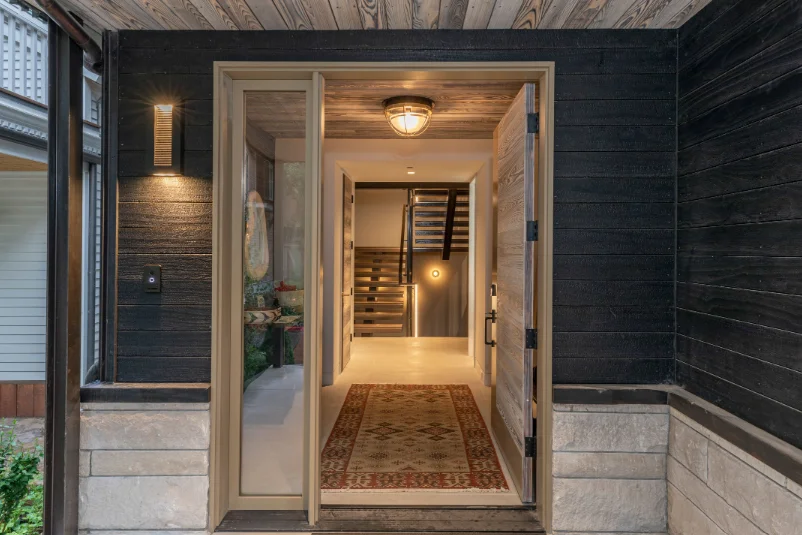




10 great examples of Japanese burnt wood siding (Shou Sugi Ban)
If you’re looking for a siding material that creates a distinctive texture but one that’s also visually striking and adds a unique character to the exterior, look no further than Japanese burnt wood siding, also known as Shou Sugi Ban.
03.20.2023

What is Shou Sugi Ban?
Shou Sugi Ban has been around for hundreds of years and has a long history in Japan. The technique—which includes burning the surface of the wood to create a layer of char that protects it from weathering, insects, and rot—originated in the 18th century to help preserve cedar siding on traditional Japanese homes and temples.
Shou Sugi Ban then gained popularity worldwide, with designers, architects, and homeowners using charred Accoya wood for various applications. Its durability, sustainability, and unique appearance make it a sought-after material for modern residential and commercial design projects.
Here are 10 stunning examples to inspire you if you consider installing for your Shou Sugi Ban house or other projects.

Modern touches meet sustainability
For this ultra-modern home, Shou Sugi Ban is aesthetically beautiful, and the dark finish also achieves a striking, standout appeal. Utilizing charring as a surface treatment is a natural, sustainable, non-toxic alternative to treated wood that harms people and the environment.

Beautiful and energy efficient
This Passive House in Utah is not only sustainable and energy efficient, the gorgeous exterior is wrapped in charred Accoya wood, fitting the eco-conscious theme—but is designed to last, providing stability throughout the seasonal changes in Utah.

Chicago two-tone
This simple two-story home in Chicago used two shades of charred Accoya wood. The base is concrete, while the upper levels used an Accoya wood façade system in two different shades – grey and black. The façade mirrors the internal arrangement of the two floors. Not so simple anymore!

Swimming in design
Sometimes a pool house is just a pool house, but in this case, the homeowner went deep and chose Accoya Barnwood Siding in Delta Black by Delta Millworks. The result is a modern, beautiful structure that will delight the homeowners to enjoy during the summer and show off at future pool parties.
2023 Design Trends
Design trends come and go, but the staying value of core house color design doesn’t stray too far from keeping it neutral. Homeowners can complement house color design with mixed materials to achieve their desired design goals.
The total value of remodeling projects in 2023 is expected to be nearly $450 billion, says the Joint Center for Housing Studies of Harvard University. So, whether a homeowner is remodeling or building a new custom home, they want home design styles and products to match their vision. In an era emphasizing durability, sustainability, wellness, and less maintenance, products that last and perform will gain in usage and popularity.

Landscape Timber Ideas for a Natural Appearance
Are you looking for natural hardscape materials to add structure or a framework for your landscaping projects? Consider wood. Naturally sustainable, wood is a versatile material with a small carbon footprint compared to other materials like concrete, stone, and metal. Whether restoring a garden area or starting a new project, timber is an excellent choice that adds beauty, warmth, and endless options to hardscape designs. Here are some of our favorite landscape features that are ideal for using wood:
11.08.2022

Top 10 Uses For Wood in Landscape Designs
1. Edging and Borders: define a garden bed or mark a path or walkway with wood timbers, so the plants, flowers, and trees will stand out and not compete with the border material. If using wood timbers for raised beds, consider a vertical design or stack horizontally to prevent erosion. Use stainless steel connectors to keep pieces aligned, especially for angles.
2. Retaining Wall: a wood retaining wall is a perfect way to blend in naturally, mainly if the wall is a focal point or a large part of a small space.
3. Steps: for graded or steep spaces, add wood steps into the landscape for a graded and easy way to make the trek uphill.
4. Decking: the most common decking material in North America is wood, and there’s nothing like natural wood under bare feet.

5. Pergolas and Gazebos: a covered space, like a pergola or gazebo, offers respite from warm days — even rainy days — and can offer an anchored space or focal point to a design.
6. Play Structures: design play structures for the little ones that are not only fun but beautiful using wood. Not just any wood. Wood that is free of toxic chemicals for peace of mind.
7. Bridges: water features add to the landscape’s design and offer tranquility to the end user. Adding an accent feature like a wooden bridge is an excellent finishing touch.
8. Planters: wooden planters — free-standing to window boxes — are great for space-challenged areas or for an added design feature to highlight trees and plants.
9. Outdoor Furniture: A recent article by Houzz notes that wood is the “go-to option for outdoor furniture” because “it is long-lasting” and can “handle different weather conditions.”
Specify Accoya wood in your next landscape designs. Our modification process gives Accoya unrivaled durability and resistance to rot, making it perfect for demanding exterior and in-ground landscape applications. Non-Toxic, Accoya offers an unmatched 50-year warranty for above ground applications and 25 years below ground or in fresh water. Find out more about the benefits of Accoya wood.

Decks That Impress: 4 Reasons to Choose Real Wood Decking by HOUZZ
Looking to refresh your outdoor area? Find out why a natural wood deck is the best place to start
10.10.2022

When it comes to enhancing your outdoor space, it’s hard to beat a beautiful deck. If you’re considering one, you’ve got some decisions to make since decks come in all sizes, shapes and materials. Whether you’re looking to extend your living space with a back deck, enhance the lounge area around your pool, add a roof deck for relaxing or install a durable dock, here are four compelling reasons to opt for real wood as your decking material.

1. Natural Beauty
For warmth and natural appeal, nothing compares with real wood as a decking material. With its beautiful texture and rich tones, wood’s authentic look oozes rustic charm and instantly elevates your outdoor entertaining space. What’s even better? If you’re after a more modern, on-trend look, you can reap the benefits of real wood with an extra touch of style thanks to pre-greyed decking boards.
Real wood is practical as well. It’s incredibly durable and able to stand up to the elements, regardless of the climate. And it feels wonderful to walk on, being warmer underfoot in winter and cooler in summer than other outdoor materials such as concrete, pavers and composite decking. Not only that, but the right wood is resistant to cracks and splinters, so it’s barefoot-friendly and still feels smooth over time.
Love the idea of real wood decking but concerned about the upkeep? You needn’t be — there are innovative new products on the market that give you all the beauty of real wood with none of the drawbacks. High-performance acetylated wood decking, which is made from quick-growing, responsibly sourced pine, boasts the good looks of tropical hardwood in a rot- and crack-resistant material that requires practically zero maintenance.
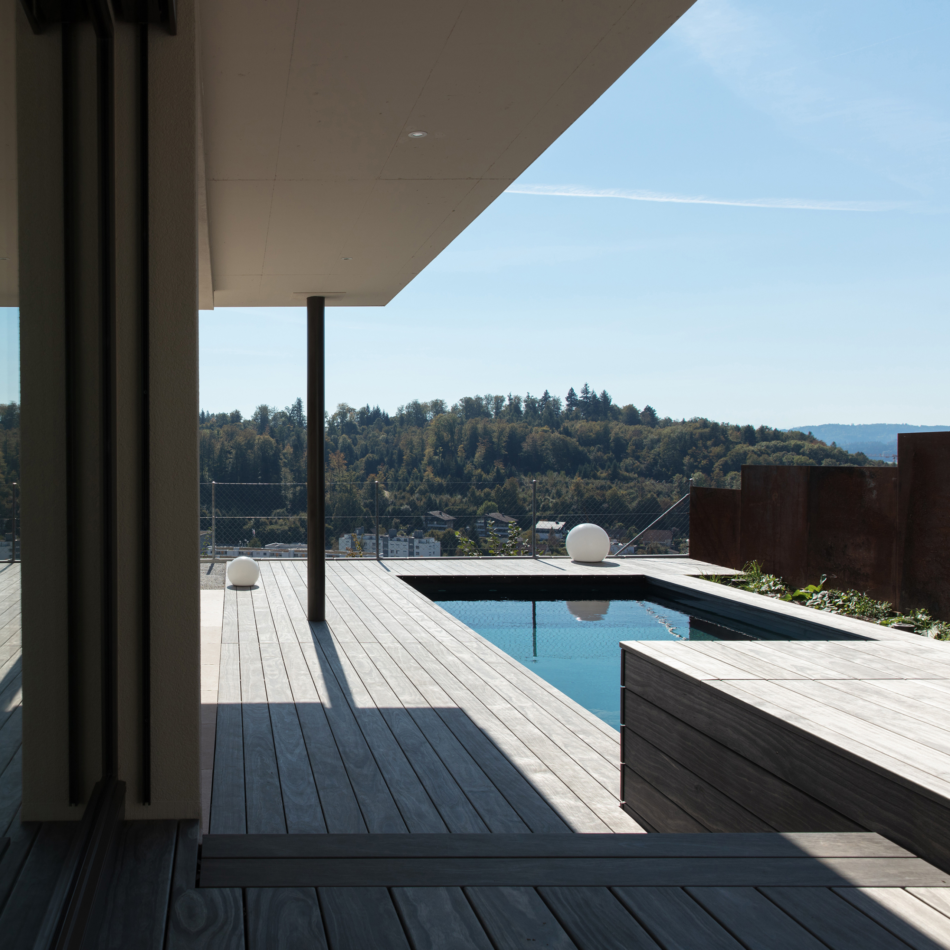
2. Stands Up to Its Surroundings
Whether you’re building a pool deck, a rooftop deck or a dock, real wood can be a durable choice, effective against rot and decay even when in contact with water. But it’s important to select the right type of wood: Pine and western red cedar are popular choices for wet areas like poolside areas and hot tubs. However, untreated wood can splinter (not ideal for those barefoot summer days by the water) and require regular upkeep to maintain its appearance.
Acetylated wood, on the other hand, is an extremely hard-wearing and easy-care alternative. It doesn’t require any coating and it resists rot, splintering and insect attacks, even in water. And unlike many other types of wood, it offers exceptional dimensional stability, which means the boards won’t visibly shrink or swell when subjected to rain, sun, heat and cold, so they’ll retain their smooth, tailored appearance for decades. Acetylated wood outlasts many other types of wood by decades, with manufacturers providing a 25-year in-ground or freshwater warranty and a 50-year above-ground warranty.

3. Ages Beautifully
Unlike synthetic decking materials, genuine wood decking ages gracefully over time, acquiring a beautiful silvery grey patina that adds style and depth to your outdoor area. If you’d prefer not to wait around for the natural aging process to occur, you can purchase pre-greyed decking boards that are dyed all the way through from the surface to the core. Because of the sophisticated non-toxic dyeing process, there’s no need for repeated painting or recoating to maintain the wood’s good looks. The grey color remains long-term, with no need for re-oiling. (It also means that scratches and scrapes won’t be visible.)
Pre-greyed wood decking is an increasingly popular choice for designers and homeowners who are drawn to its sophisticated look and feel and the fact that it allows for a seamless connection with concrete or grey-tiled interior floors. Grey wood also sits beautifully alongside other popular exterior materials such as brick, slate and stone to create a warm and appealing outdoor palette.

4. Sustainably Sourced
Responsibly sourced and manufactured wood decking is an environmentally friendly material so it’s better for the health of your family and Earth. If you’re interested in going green, look for real wood with FSC (Forest Stewardship Council) certification for proof of sustainability. You’ll also want to check that it has been manufactured cleanly, without the use of toxic chemicals. One indication? Cradle to Cradle Gold (C2C Gold) certification, a globally recognized measure of a safer, more sustainable product.
More: To discover Accoya’s selection of high-performance, real wood decking options, visit the company’s website.
This story was written by the Houzz Sponsored Content team.

Decks That Impress: 4 Reasons to Choose Real Wood Decking by HOUZZ
Looking to refresh your outdoor area? Find out why a natural wood deck is the best place to start
12.20.2021

When it comes to enhancing your outdoor space, it’s hard to beat a beautiful deck. If you’re considering one, you’ve got some decisions to make since decks come in all sizes, shapes and materials. Whether you’re looking to extend your living space with a back deck, enhance the lounge area around your pool, add a roof deck for relaxing or install a durable dock, here are four compelling reasons to opt for real wood as your decking material.

1. Natural Beauty
For warmth and natural appeal, nothing compares with real wood as a decking material. With its beautiful texture and rich tones, wood’s authentic look oozes rustic charm and instantly elevates your outdoor entertaining space. What’s even better? If you’re after a more modern, on-trend look, you can reap the benefits of real wood with an extra touch of style thanks to pre-greyed decking boards.
Real wood is practical as well. It’s incredibly durable and able to stand up to the elements, regardless of the climate. And it feels wonderful to walk on, being warmer underfoot in winter and cooler in summer than other outdoor materials such as concrete, pavers and composite decking. Not only that, but the right wood is resistant to cracks and splinters, so it’s barefoot-friendly and still feels smooth over time.
Love the idea of real wood decking but concerned about the upkeep? You needn’t be — there are innovative new products on the market that give you all the beauty of real wood with none of the drawbacks. High-performance acetylated wood decking, which is made from quick-growing, responsibly sourced pine, boasts the good looks of tropical hardwood in a rot- and crack-resistant material that requires practically zero maintenance.

2. Stands Up to Its Surroundings
Whether you’re building a pool deck, a rooftop deck or a dock, real wood can be a durable choice, effective against rot and decay even when in contact with water. But it’s important to select the right type of wood: Pine and western red cedar are popular choices for wet areas like poolside areas and hot tubs. However, untreated wood can splinter (not ideal for those barefoot summer days by the water) and require regular upkeep to maintain its appearance.
Acetylated wood, on the other hand, is an extremely hard-wearing and easy-care alternative. It doesn’t require any coating and it resists rot, splintering and insect attacks, even in water. And unlike many other types of wood, it offers exceptional dimensional stability, which means the boards won’t visibly shrink or swell when subjected to rain, sun, heat and cold, so they’ll retain their smooth, tailored appearance for decades. Acetylated wood outlasts many other types of wood by decades, with manufacturers providing a 25-year in-ground or freshwater warranty and a 50-year above-ground warranty.

3. Ages Beautifully
Unlike synthetic decking materials, genuine wood decking ages gracefully over time, acquiring a beautiful silvery grey patina that adds style and depth to your outdoor area. If you’d prefer not to wait around for the natural aging process to occur, you can purchase pre-greyed decking boards that are dyed all the way through from the surface to the core. Because of the sophisticated non-toxic dyeing process, there’s no need for repeated painting or recoating to maintain the wood’s good looks. The grey color remains long-term, with no need for re-oiling. (It also means that scratches and scrapes won’t be visible.)
Pre-greyed wood decking is an increasingly popular choice for designers and homeowners who are drawn to its sophisticated look and feel and the fact that it allows for a seamless connection with concrete or grey-tiled interior floors. Grey wood also sits beautifully alongside other popular exterior materials such as brick, slate and stone to create a warm and appealing outdoor palette.

4. Sustainably Sourced
Responsibly sourced and manufactured wood decking is an environmentally friendly material so it’s better for the health of your family and Earth. If you’re interested in going green, look for real wood with FSC (Forest Stewardship Council) certification for proof of sustainability. You’ll also want to check that it has been manufactured cleanly, without the use of toxic chemicals. One indication? Cradle to Cradle Gold (C2C Gold) certification, a globally recognized measure of a safer, more sustainable product.
More: To discover Accoya’s selection of high-performance, real wood decking options, visit the company’s website.
This story was written by the Houzz Sponsored Content team.

4. Focus on Natural Materials
As the saying goes, less is more. Choosing one “hero” natural material and using it in different ways across your home’s exterior can be a subtle, but very effective, way to bring cohesion to your home’s design. To create an uninterrupted sense of flow, you could carry the material through to the interior of your home or to any outbuildings.
The key to success when using a single natural material is to be creative with how you apply it. This award-winning boathouse (The Haven) in Norfolk, England, has been given light-tone Accoya wood cladding, decking and curved screening. As the property is surrounded by water on three sides, the architects selected Accoya wood for its water-resistant properties and dimensional stability, as well as its stunning natural looks and sustainability. The result is a graceful home that sits lightly in its tranquil coastal setting.

5. Play Up Textures
Natural appeal aside, wood cladding gives you endlessly creative ways to express your personal style. Take this three-story office building designed and occupied by architectural firm Dillon Kyle Architects in Houston, for example. It’s clad in 2,500 Accoya boards that have an abstract leaf-like pattern carved into the wood. The pattern references the oak trees that line the neighborhood, and it adds not just texture and softness to the modern structure but a unique personal touch.
“The Accoya wood boards are unsealed and allowed to weather over time,” says Peter Klein, associate principal architect at Dillon Kyle Architects. “The idea was to use a material where you couldn’t tell where the patterns started and stopped — just one big continuous object.”
As the wood siding would play a pivotal role in the look and performance of the building, the firm took their time choosing the right one. “Even left untreated, it didn’t warp or mildew or mold, and that let us know we were on the right path,” Klein says. “The neutral gray tones coupled with its long-term durability, resistance to rot and insects made Accoya wood the ideal material for this project.”

6. Go Skinny
Add texture and depth to your home’s exterior with narrow boards for siding, louvers and screening.
For this luxury apartment block (Blackwood Street Apts) in Melbourne, Australia, the architect specified 40-by-40-millimeter Accoya wood boards with a coat of Woca Exterior Walnut Oil for the louvers and screening in the alfresco areas. The oiled boards create a soft and inviting feel while bringing a sense of intimacy to the apartment complex.
The rest of the detailing in this spot, including hardware and pavers, was deliberately pared back to keep the focus firmly on the textural wood.

Running slender boards vertically, as the architect has done here, is a clever design technique for making a low roof or ceiling appear higher. You can use this strategy both outside your home with wood siding and inside with wood wall lining.
If room height is not a concern, consider mixing vertical and horizontal patterns for added texture and interest inside or outside your home.
More: Learn more about Accoya’s range of sustainable, acetylated wood products by visiting our homepage here.
This story was written by the Houzz Sponsored Content team.

Opinion Piece by Justin Peckham “Game Changers”
In December 2020, I was asked by Futurebuild what innovations have changed the face of the built environment. Looking back over time the game changing products that I believe have influenced our work include:
04.21.2021
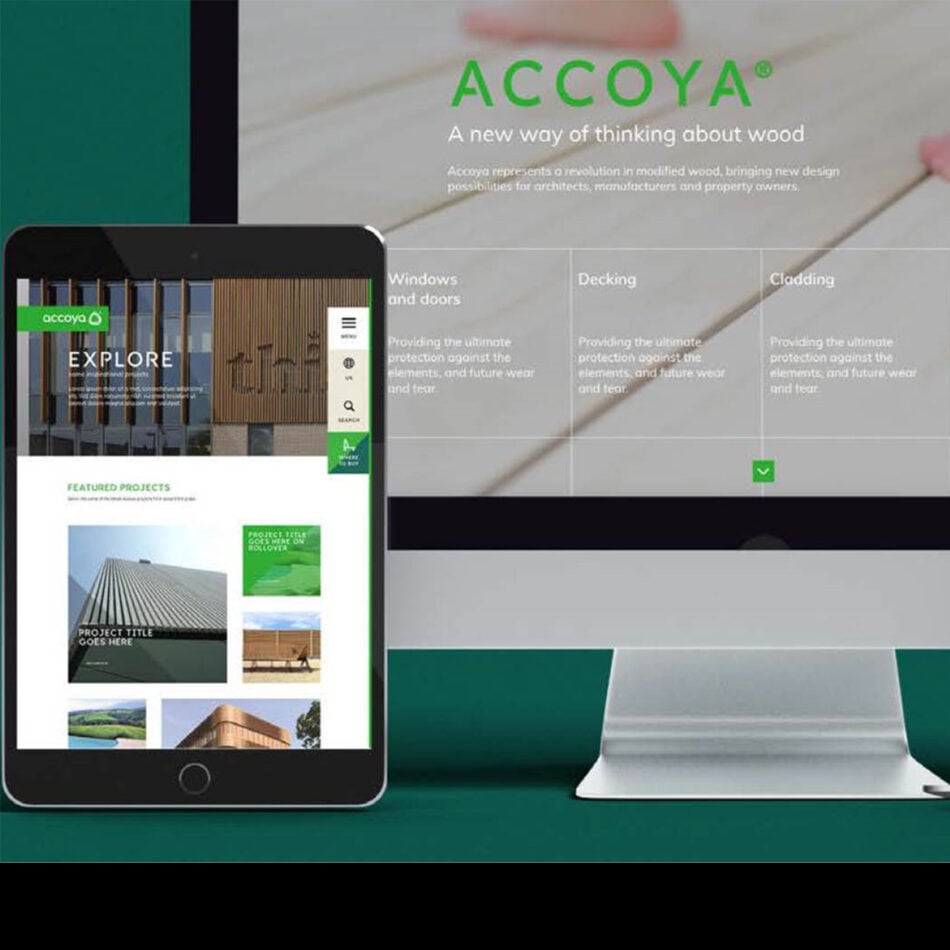
Video Conferencing Platforms
Much has already been written about how the business world has embraced video conferencing technology during this pandemic and we’ll all no doubt have personal experience of how it has changed the way that we work. So, in many ways this is an obvious choice for a game changer, but because the impact will be so far reaching I thought it worth putting in my list.
The world was probably moving towards greater use of video conferencing anyway, but there is no doubt that lockdown measures as a result of COVID-19 rapidly increased the speed of uptake. The experience has taught us that we don’t need to travel as much as we used to. Before, we thought it was imperative that we met others face to face. It has also made the use of video conferencing more acceptable, when before it might have been perceived as a cop-out by those not prepared to make the effort to meet in person.
Sure, face to face meetings are important and I have no doubt that a degree of travel will resume within our businesses once restrictions are lifted, but I also think that video conferencing is here to stay and that many of us will end up traveling less and working from home more than we used to, which has got to be a good thing for both the environment and our own well-being.
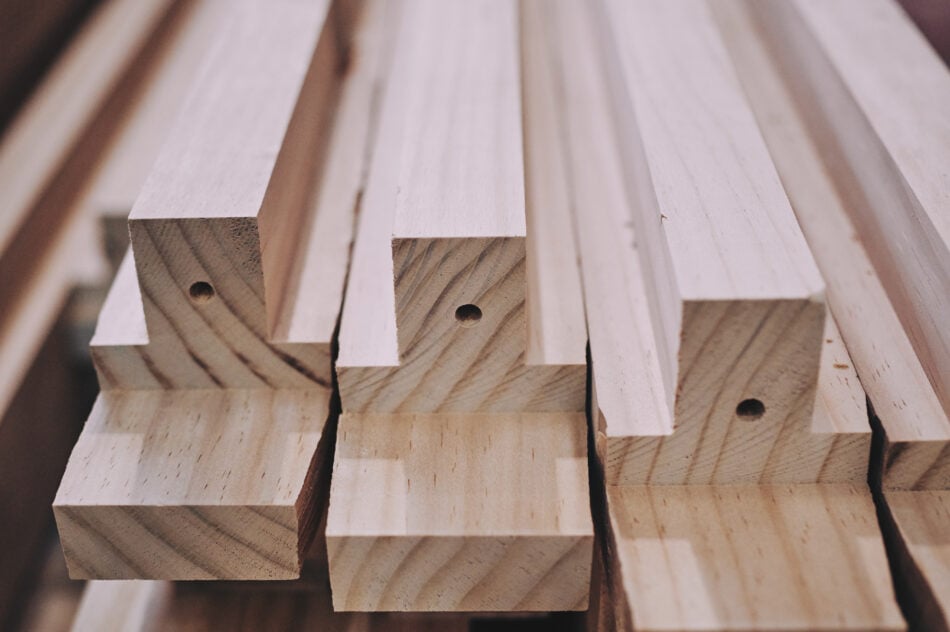
Acetylated Wood
I make no apology for listing my own company’s products here, Accoya wood and Tricoya. Even if I wasn’t involved in these products, I would have them on my list because they are such a great example of how we don’t necessarily need to compromise performance in our bid to use more sustainable products.
Photosynthesis is the best means we have of capturing carbon from the atmosphere and in the form of trees we have natural “production units” that convert it for us into a very versatile building material – wood. Using more wood in construction is vital as we aim for that carbon neutral target, yet so often specifiers choose carbon-intensive man-made materials that they have confidence in over wood because of concerns over the durability and stability of the latter.
Both Accoya (solid wood) and Tricoya (panels) are based on sustainably-grown timber which is tweaked at the molecular level by a chemical reaction called acetylation to vastly improve the performance of the wood in a non-toxic manner, thus locking in all of that sequestered carbon for decades longer than would otherwise be the case in products that are much more reliable and predictable than those made from un-acetylated wood. Both Accoya and Tricoya afford us the opportunity to significantly increase the amount of timber we use in construction without compromising on service life expectations or performance, even in challenging external applications.

LED Lighting
LED lighting technology has been gradually developing from the early 1960s to the present day so it’s sort of crept up on us rather than taken the world by storm but in my view this doesn’t make it any less revolutionary. The current generation of LED lights offer so many advantages over the older technologies that they have now become the norm for most applications. Over time they will result in significant reductions in energy use across the world both in-use and by virtue of the fact that they last so much longer than incandescent or halogen bulbs. To cap it all they can be recycled so are a good fit with the circular economy.
For more information on other game changing products or technologies see here: https://www.futurebuild.co.uk/game-changers/

Transforming your home into a staycation retreat
With holidays in many countries still looking uncertain, many may be spending even more time at home this summer. Even with the ban on international travel set to potentially lift in May, it’s not a sure thing, and many summer holiday options are already sold out! Here’s some ideas and inspiration for transforming your home into a staycation retreat.
03.22.2021
So, with no beach stays for the foreseeable future, what can you do to make your own outdoor space a treat to spend time in? It may be easier than you think to create your very own attractive al fresco area to while away the summer hours, whether basking in the sun or enjoying the long evenings. With spring now (just about) upon us and good weather hopefully on the horizon, let’s take a look at four outdoor trends we expect to see this year that will help make houses and homes into luxury staycation retreats.
Invest in the outdoors
As the covers come off this spring, we expect homeowners to once again prioritize their outdoor spaces when it comes to home improvements. Summer lockdown in 2020 saw a DIY boom with online sales of garden and home improvement materials tripling, and this year looks set to be no different.
Whether it’s building a new set of planters or digging new flowerbeds, we Brits love to garden – in fact, 42% of us regularly partake in gardening. Working in the fresh air of the garden is well known to reduce stress and boost your mental and physical well being, giving you a renewed sense of purpose and achievement (which we can all agree is much needed this year).
We all now have a golden opportunity to spend more valuable time in the garden, and for many, that will mean rolling up the sleeves and getting stuck into jobs like recoating our deck and repainting the garden furniture.

The natural charm of timber decking
Timber remains the classic choice for outdoor decking, despite advancements in alternative materials, and it can certainly enhance the look of any garden. Choosing the right timber decking to complement your outside space is critical though, and there are some considerations to bear in mind including a budget, maintenance and style.
Wood is warm and beautiful and can give your garden a natural charm that you just can’t achieve with plastic. It is easily cut and shaped to work around your existing garden features and can be stained, treated or colored with a vast range of coatings and textures to suit your look. Installation costs tend to be lower than other materials, and depending on your budget, there are plenty of different options, such as softwoods, hardwoods and modified woods such as Accoya®. When it comes to maintenance, more durable species or modified wood are good options with less regular upkeep required to keep your deck looking pristine all year round. Finally, don’t forget that sourcing environmentally friendly timber decking should always be on your radar, so look for the FSC® certification if in doubt.

Escape to the garden office
There’s no doubt that COVID-19 has fundamentally changed the way we work. Although permanent home working is likely to be gradually replaced by a flexible hybrid office/home model as restrictions ease, there will still be thousands of us tapping away on laptops at home this year. So, it’s no surprise that we’re seeing demand for garden offices soar as workers seek a quiet space outside away from the noise of the house.
Garden offices tend to be entirely separate from the house, fully insulated with heating and built for all weather conditions. Depending on space, they can range in size from a single person room to a fully kitted out office with a built-in kitchen and bathroom. Cheaper than a house extension, garden offices also come with significantly less environmental impact, particularly if built from or clad in sustainable timber.

Get outdoor cooking
A year of stay-at-home restrictions has elevated the need to fully maximize any outdoor space you may have, improving both functionality and aesthetics. According to Google Trends, searches for ‘outdoor kitchen ideas’ have surged by 60% since the start of the year, and they’re a great way to extend your available interior space for alfresco dining with friends and family. If you’re missing that feeling of cooking outside on a barbecue in the early evening sunshine on holiday, this might be one for you.
Outdoor kitchens can be anything from a simple built-in barbecue to a full kitchen with a sink, preparation space and even a fridge. They can be built as a DIY job or made fully custom, but when buying make sure you consider durability just as you would with any outdoor furniture which may come under attack from the weather.
Instead of more vulnerable materials like scaffolding wood, try a kitchen built with Accoya wood or Tricoya MDF board which have both been preserved through a unique acetylation process and will last far longer in wet (and dry) conditions – perfect for an outdoor kitchen that will last for many more summers to come!
Blogs
You may also like

The sustainable outdoor kitchen
Do you like the idea of cooking outdoors? Bring the holiday feeling to your garden with the ultimate Accoya Sustainable Outdoor Kitchen.

Make the most of a small garden
Oxford Planters have shared their 6 tips to maximise a small garden.

On-Trend Exteriors by HOUZZ
A beautiful home exterior is like a welcoming smile, lifting your spirits whenever you pull into your driveway or walk up to the front door.

Accoya® selected by the prestigious Cambridge University for unique botanic gardens project
Where to Buy
You can buy Accoya and Accoya products from our selection of distributors or manufacturers in your region. Use our map search tool to find your nearest Accoya supplier.

5 Ideas to Steal From These Gorgeous, On-Trend Exteriors, by HOUZZ
Boost your home’s curb appeal with eye-catching materials, finishes and more
03.16.2021
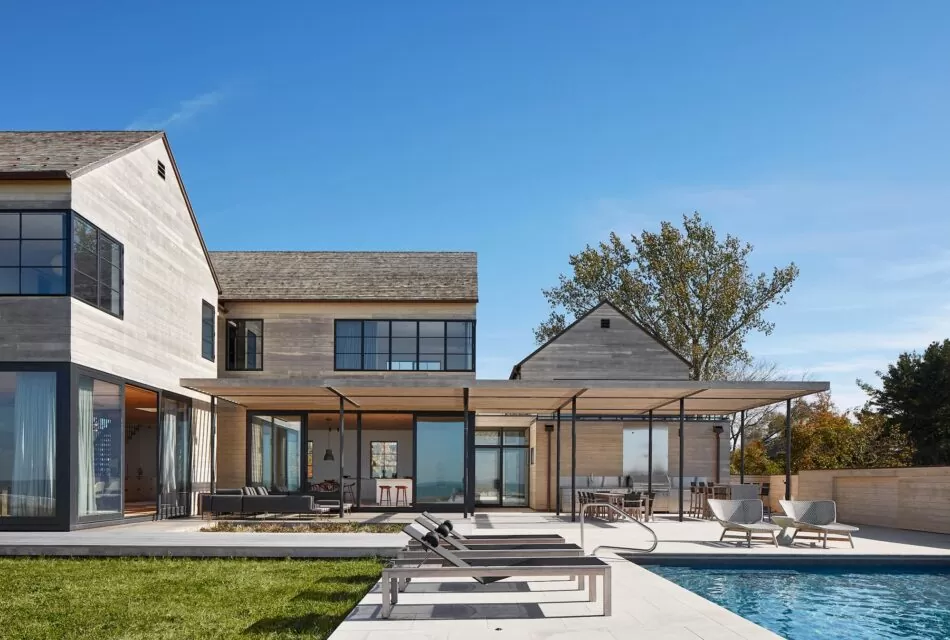
1. Look to Nature
Embrace the biophilic trend and celebrate your natural surroundings with an unpainted wood exterior. Add a clear coating to preserve the wood’s original hue or let it weather to a beautiful soft grey, as seen on this home in St. Joseph, Michigan. Its acetylated wood siding pops against the black window frames and is low-maintenance, durable and resistant to rot, insects and fungi.
Acetylation is the process of modifying wood with a concentrated vinegar, “which makes it so that the wood doesn’t stay wet,” says Tim Svarczkopf, a technical manager at Accoya, a company that creates acetylated wood. It reduces the shrink and swell by 75% and allows Accoya to offer a 50-year warranty. “If the wood hardly swells and doesn’t rot for 50 years, the applications are virtually limitless,” Svarczkopf says.

2. Go Monochromatic
Exude modern sophistication with a dramatic exterior in a single color. Ideal for transitional-style homes, like the one seen here one in Bethesda, Maryland, it can work well for a multitude of aesthetics. The key is to vary the tones and textures to bring much-needed depth. The siding seen here was charred using the ancient Japanese technique of shou sugi ban.
If painted wood is more your style, be sure to choose lumber that won’t swell or shrink too much — movement causes cracks. “The coating is going to last significantly longer that way,” says Ty McBride, a renovator in Oklahoma City. He uses acetylated wood — which is resistant to bowing, twisting and warping — for his projects, keeping maintenance and future repair costs to a minimum. Svarczkopf adds, “It can be used without maintenance of any kind and still not decay. If the owner wants the wood to look nice, they’ll likely want to clean it annually.”
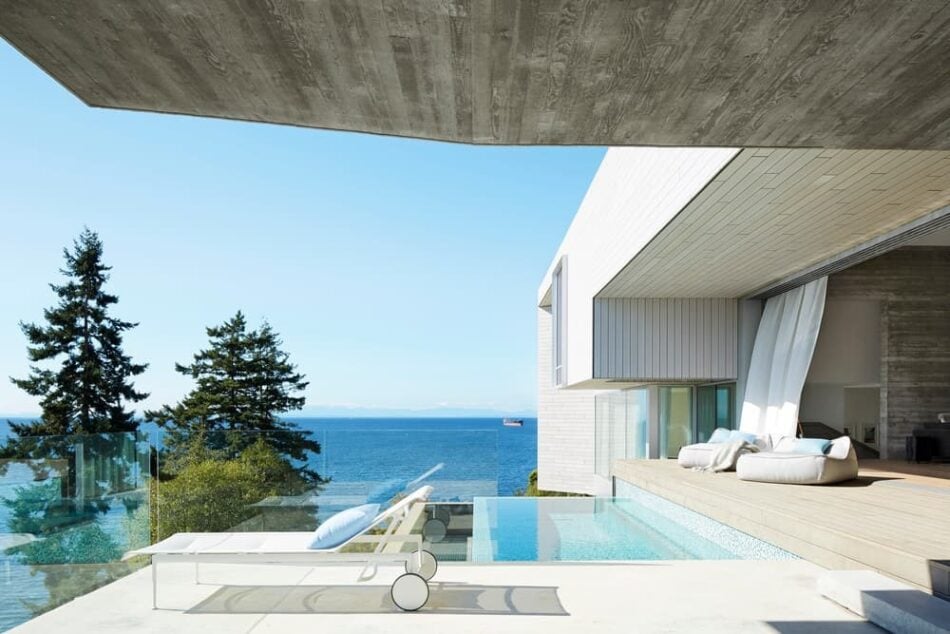
3. Embrace Bold Minimalism
Modern minimalist architecture, with its clean lines and simple color palettes, continues to pop up in Houzz’s most-saved photos. Impressive use of volume, shape and contrasting materials — such as sleek metal and textural stone — adds visual interest and turns heads.
Acetylated wood decking brings visual warmth to the modern home in West Vancouver seen here, acting as a counterpoint to the expansive glass and rough concrete. While salt crystals may form on the planks, the coastal environment won’t have any effect on the wood itself, Svarczkopf says. The deck won’t splinter and can be enjoyed all year round with minimal upkeep. “Friends who use acetylated wood in coastal regions rave about it,” McBride says.

4. Opt for Expansive Glass
Let in the light with large glass doors and walls of floor-to-ceiling windows to create an airy, welcoming look both inside and out. This popular design trick will visually expand your home and connect you to nature and all of its soothing effects. Use glass or thin cable railings on decks to maintain clear views.
The house in Auckland, New Zealand, seen here fully embraces the trend with plenty of indoor-outdoor spaces. Its acetylated wood windows and doors help with insulation and keep energy bills down. The low-density material traps heat in air pockets, Svarczkopf says, stopping it from traveling quickly from the inside to the outside and vice versa. “The density is really great for thermal insulation,” McBride says. “It doesn’t conduct heat the same way as aluminum and vinyl.”

5. Combine Styles
Mix contemporary and traditional styles for a new exterior look that’s all your own. “Sleek” and “simple” are the watchwords of this approach to help you avoid anything too mismatched. Think neutral hues, clean lines and minimal detailing. For example, consider one large picture window instead of multiple mullioned designs.
A modern addition imbues this shingled home in Bellport, New York, with fresh style while preserving its historic character. The new space features simple windows and charred acetylated-wood siding, chosen for its durability and sustainability. Certified by the Forest Stewardship Council and the Cradle to Cradle Products Innovation Institute, among others, the siding is fully biodegradable. “The waste isn’t going to impact the environment, as opposed to cement board, vinyl or aluminum,” McBride says. Svarczkopf notes, “It’s also a very fast-growing renewable resource and a carbon-sequestering product. The fact that it lasts for so long and needs less maintenance enhances the life cycle benefits.”
This story was written by the Houzz Sponsored Content team.
To see the article on HOUZZ, please click here.
Where to Buy
You can buy Accoya and Accoya products from our selection of distributors or manufacturers in your region. Use our map search tool to find your nearest Accoya supplier.

Cross-laminated timber – Sustainable buildings to reach for the skies
Gone are the days where concrete and steel, with their considerable environmental costs, are the only building materials that can be used to erect skyscrapers. Modern techniques and one of the world’s original building materials mean high-rise buildings can be more sustainable than ever before.
01.12.2021
Cross-laminated timber
Wood is natural and renewable, and is now enjoying a renaissance with innovative engineering, modification and construction methods: it is unlocking new ways of thinking about constructing tall buildings across the world’s skyline.
Cross-laminated timber (or ‘CLT’) is one of the main engineered wood contributors to the creation of these new ‘plyscrapers’. Interlocking cross laminated timber panels are made by gluing layers of solid-sawn timber together, usually in alternating pattern of orientation to improve structural rigidity. In very broad terms, it’s a bit like plywood but on a much larger, thicker and stronger scale.
CLT panels are strong enough to support high loads, much lighter than concrete and steel, and can even be cut to fit when on-site – including all the door and window openings. This can make the actual construction phase easier to manage, quicker, and logistically a lot simpler.
First introduced in the 1990’s CLT or Cross-laminated timber enables architects or engineers to design and build tall, beautiful buildings, while still being kind to the environment too: as a wood product, it contains and locks in the carbon used by the original tree to grow, safely storing it in a solid useful form in the structure.
There are CLT projects all around the world. Here are just a few examples located in the United States: eight-story in Brooklyn, New York, Carbon12 building in Portland, Oregon and a six-story dormitory at Rhode Island School of Design in Providence.
In Canada, Norway, Sweden, UK and Australia, even taller wooden buildings are already in use.
Discover where you can buy Accoya in your country or region.

The Mjosa tower in Brumunddal, Norway is only 25 feet shorter than the Statue of Liberty! Credit: Metsä Group
Accoya wood
Accoya wood has often been used as a ‘perfect partner’ to mass timber buildings: complementing the interior and structural CLT frame with exterior surfaces and joinery that’s incredibly durable, dimensionally stable and resistant to the elements.
Where the choice of materials was crucial and timber was selected and used, the following projects come to mind.

Christies Care Home – UK
The entire structure of the building, including the external walls, is CLT timber combined with glulam columns and beams with Accoya external wall cladding. This project calculated to sequester 180 tons of carbon, which in terms of embodied energy, much more than offsets the transport from Austria.

Wood City – Finland
A new building complex, now known as ‘Wood City’, was built in downtown Helsinki, Finland. The complex was developed in two phases, with the first phase consisting of residential buildings and the second phase including a hotel, offices and a courtyard. The buildings are eight stories tall and are fully constructed of wood, including the supporting structures from CLT. This makes the project distinctly different from others and Accoya has been selected as the wood of choice for the exterior siding due to the project having sustainability at the forefront of its mind.

Wilkinson Eyre Modular village – UK
Designed by WilkinsonEyre, the village can accommodate up to 50 students with visiting staff. The high-quality and energy efficient living pods are prefabricated from cross-laminated timber (CLT), using Accoya and other materials for rapid on-site assembly. They are arranged in units and rising two to three-stories to create a welcoming social space on the campus alongside the larger industrial buildings.
Sustainable building
Building without compromise, sustainability can be truly embedded in our buildings. The option is there to make our monuments to the skies into giant carbon stores instead of high embodied carbon-cost monoliths; to build our biggest buildings out of wooden CLT and Accoya instead of mined, refined and heavily processed aluminum, glass and concrete.
Where to Buy
You can buy Accoya and Accoya products from our selection of distributors or manufacturers in your region. Use our map search tool to find your nearest Accoya supplier.

Future trends by Accoya
How to make a statement using this versatile material
10.27.2020

Hot home exterior trends
Your home’s exterior says a lot about your style. Here’s a look at four home exterior trends we’re seeing.
1. Increased Use of Natural Wood
Home designers are increasingly using natural products like stone and wood – partly because they look good and partly because they want to use sustainable products. Accoya is made using FSC® certified, responsibly harvested wood. It is also non-toxic and contains no harmful chemicals.

Have fun with color
2. Use of Color to Make a Statement
Natural wood is a hot look that is here to stay. For siding and decking, Accoya can be left to weather naturally, leaving a beautiful silver patina. Looking for something more dramatic? Coating your exterior is also a great option. Black and dark-gray exteriors are in right now. In fact, many designers are combining dark colors with natural wood for a stunning result. And interestingly, designers recognize that black can be used to make small structures look bigger.
Because Accoya is made from real wood, it lends itself well to paint or stain. It’s naturally light in color, giving you even more flexibility to be creative with color since it absorbs coatings well. Accoya readily accepts and retains dark colors, which means you won’t have to repaint or re-stain for years.
- Can you stain Accoya? Yes! Many homeowners are going transparent, to retain that natural wood look, which fades to a lovely natural silver-gray patina. But if natural is not your thing, you can stain Accoya any color, even black, using either oil- or water-based stains.
- Can you paint Accoya? Yes! Several designers have used bright, bold hues that help create a statement. Others have gone with classic white for that timeless, modern farmhouse look. You decide.
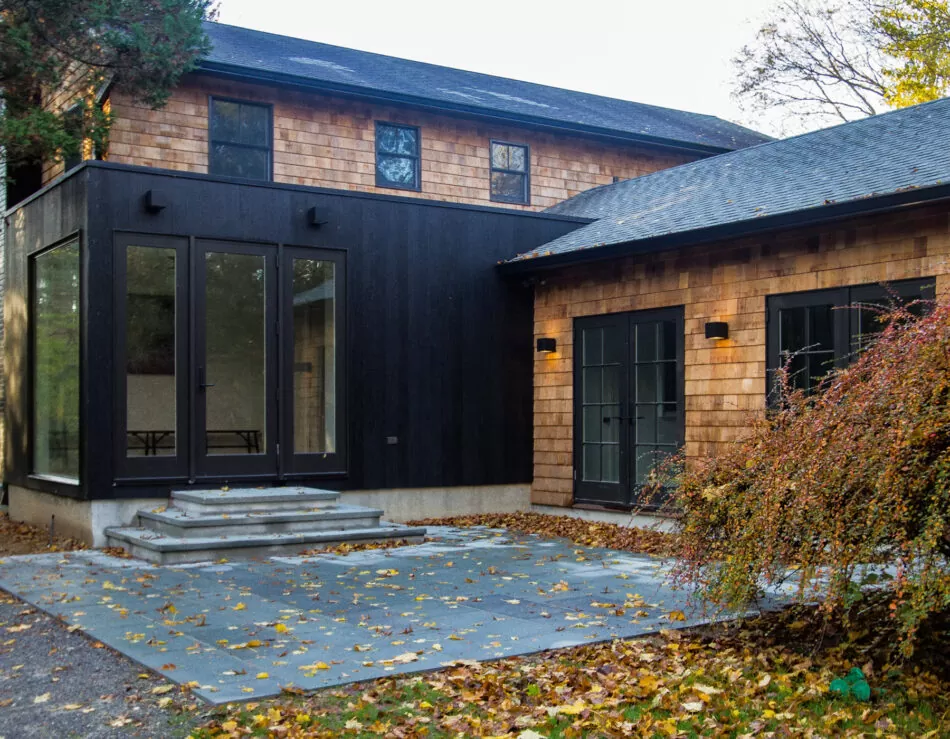
Make a statement with charred wood siding
3. Using Texture to Make a Feel-Good Statement
One popular way to add texture and drama is with Shou Sugi Ban, a traditional Japanese art of charring wood. The process leaves a beautiful dark charcoal finish on Accoya that complements the wood grain. The practice is well-suited for cladding or siding options because it provides excellent durability that will stand up to the elements. You can use it all over your home, or just to create an eye-catching feature that will stand out from the rest of your home’s exterior.

Stand out with mixed materials
4. Mix it Up
Don’t limit yourself; mixed materials are a hot trend. You can use Accoya wood with board-formed cement, brick, stone or stucco – even all of them if you’re feeling adventurous. Use with any design, from traditional to transitional, modern farmhouse to classic renovation… and everything in between.
So what are the biggest trends?
So, what are the biggest trends we see? That there are no hard and fast rules. That quality and authenticity counts, especially when it comes to the environment. And that no one wants to be a slave to maintenance.
If that’s what you’re seeing on your horizon, then look to Accoya. You can customize it with colors, coatings, textures and treatments to make a neighborhood statement that’s all yours.
PROJECTS
Projects you may like…
Where to Buy
You can buy Accoya and Accoya products from our selection of distributors or manufacturers in your region. Use our map search tool to find your nearest Accoya supplier.

Black is Back! Charred timber is all the rage amongst architects and designers
10.31.2019

Due to numerous beautiful realisations around the world, Yakisugi is enjoying an increase in popularity.
In the last two years this ancient Japanese technique has been rediscovered and is now reinventing the way modern constructions are using materials today, but what is it?
This is the traditional Japanese art of charring cedar, originally a way of preserving the wood, essentially making it more durable. Typically suited for cladding or siding options nowadays architects and designers from North America to Europe as well as Japan are specifying charred timber for a variety of applications, using different types of timber, with unique benefits.
Charred Accoya has now been added to the range of traditional timbers giving architects even more choice. Accoya a modified timber manufactured using Accsys’ proprietary acetylation process, delivers remarkable levels of stability, sustainability and durability. Exceeding the high quality and aesthetic attributes of tropical hardwoods, Accoya wood withstands the most extreme external environments.

Why Charred Accoya?
For some manufacturers Accoya is the preferred timber of choice. Due to Accoya’s outstanding stability, the charring process works well. Boards don’t twist, distort or warp when subjected to the charring, making it ideal for ease of installation on a building site.
Durability is not only enhanced when using Accoya but the charring prolongs any finish making it long lasting even with the additional stability of Accoya once in situ.
An additional feature of Accoya, a solid wood, is that the grain is emphasised much more than any other timber due to how well the process chars Accoya. The process makes it an attractive timber for cladding, siding and even internal feature walls.
Charred Accoya has been used in several projects already. Take a look for yourself.


Traditionally charring timber until it turns to charcoal black was the only option but now manufacturers using this technology have broaden their range with added treatments/colours to achieve long lasting features. New techniques to enhance the timber’s aesthetics, offering traditional, highly charred, heavily textured looking timber in sleek and contemporary finishes is offering architects and designers the freedom to design whilst achieving the look and finish they desire.
See more charred Accoya projects here.
And have a look at where you could buy Accoya wood from today!
Where to Buy
You can buy Accoya and Accoya products from our selection of distributors or manufacturers in your region. Use our map search tool to find your nearest Accoya supplier.

Black is Back! Charred timber is all the rage amongst architects and designers
02.21.2019

Due to numerous beautiful realisations around the world, Yakisugi is enjoying an increase in popularity.
In the last two years this ancient Japanese technique has been rediscovered and is now reinventing the way modern constructions are using materials today, but what is it?
This is the traditional Japanese art of charring cedar, originally a way of preserving the wood, essentially making it more durable. Typically suited for cladding or siding options nowadays architects and designers from North America to Europe as well as Japan are specifying charred timber for a variety of applications, using different types of timber, with unique benefits.
Charred Accoya has now been added to the range of traditional timbers giving architects even more choice. Accoya a modified timber manufactured using Accsys’ proprietary acetylation process, delivers remarkable levels of stability, sustainability and durability. Exceeding the high quality and aesthetic attributes of tropical hardwoods, Accoya wood withstands the most extreme external environments.
Why Charred Accoya?
For some manufacturers Accoya is the preferred timber of choice. Due to Accoya’s outstanding stability, the charring process works well. Boards don’t twist, distort or warp when subjected to the charring, making it ideal for ease of installation on a building site.
Durability is not only enhanced when using Accoya but the charring prolongs any finish making it long lasting even with the additional stability of Accoya once in situ.
An additional feature of Accoya, a solid wood, is that the grain is emphasised much more than any other timber due to how well the process chars Accoya. The process makes it an attractive timber for cladding, siding and even internal feature walls.
Charred Accoya has been used in several projects already. Take a look for yourself.

How do you choose the right wood for a wooden terrace?
Exposure to the wind and weather, moisture and extreme temperature differences, wooden terraces have a lot to cope with. The right material must combine durability, strength, wear resistance and good machinability. As well as potential considerations like not splintering, or the risk of fungi when in contact with the ground.
Based on their natural durability, different wood species fall into 5 durability classes. With Class 1 the most durable and class 5 not very durable.

Sitting outside for a large part of the year?
Then you will want some cover. A shady spot, protecting you from the bright sun while enjoying your garden. Even in winter you can sit outside with a fire or heat lamps and keep an unobstructed view of your garden. Outside is the new inside. If you take a sunshade, you can lose part or all the view towards your garden. A good quality pergola or terrace roof can have a long life when using the right materials. If you take care of the necessary cleaning yourself, you can enjoy your terrace roof for many years. Almost half of new patio roofs are made of wood due to the many advantages wood provides.
We’ve listed them for you:
- Wood has a natural and warm appearance. This makes a wooden terrace roof suitable for almost every home.
- Wood comes in many types, colours and textures. So you can choose the type of wood that suits you and your home best.
- Wood is easy to work with, increasing design possibilities and ease of installation.
- Wood is durable. Especially if you take a terrace roof made of durable Accoya® wood, you have little or no maintenance. Such roofs have a 50 year guarantee against rot.
So we look forward to seeing much more garden woodwork in 2019.


Projects
Projects
Where to Buy
You can buy Accoya and Accoya products from our selection of distributors or manufacturers in your region. Use our map search tool to find your nearest Accoya supplier.
WHERE TO BUY ACCOYA
for your next projectWhat type of Product are you interested in?
- - Select product type -
-
FIND A SUPPLIER
FIND A INSTALLER
for your next projectWhat type of are you interested in? (optional)
How will your be used?
- - Select type -
-
You are currently on the Accoya site
Would you like to visit the Accoya Site to view all relevant content for your location?

